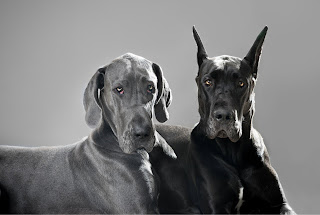Dog blog 15 - ice cream
 Ice cream
Ice cream
Dave and I have been immersing ourselves recently in the philosophy of language.
There's a lot of stuff in it like: Smith says "A" to Jones; what does Smith mean by "A"? Can Smith successfully communicate "A" to Jones? And what does "meaning" itself mean?
Tricky. Although Dave and I were both delighted to discover that philosopher Willard Van Orman Quine bases one of his theories on a thought experiment involving rabbits.
Worry
Anyway, in doing all our readings, Dave and I managed to get ourselves quite worried about whether we were actually understanding each other at all.
I mentioned to Dave one afternoon that I was "particularly fond of vanilla ice cream, on a cone". But could we be confident that we really knew what each other meant? A worry indeed.
Incidentally, that's Bernard above, demonstrating the Dog's preferred ice cream eating technique. Getting it all over your face and nose. And making a bit of a mess. Brilliant.
The philosophical problem of vanilla ice cream
Vanilla ice cream poses a classic problem in philosophy of language. John Locke was wondering about it way back in the 17th Century, in his book An Essay Concerning Human Understanding. John used flowers as his example (violets and marigolds); Dogs prefer ice cream though.
I might have in my mind the idea of a lightly flavoured vanilla ice cream, on a cone, like Bernard is eating; Dave on the other hand (not unlikely, I might add), might be thinking of something utterly bland, sitting atop a banana. Perhaps on a banana split, like this (but in Dave's case with vanilla ice cream scoops only):
Towards understanding
Faced with such possible levels of confusion and misunderstanding, what were we to do?
Dave had the idea. We'd go down to our favourite local ice cream van. And order two pretty (in both senses) identical cones, with a similarly sized scoop of vanilla ice cream. From the same tub. And then we'd eat our ice creams, and the cone, in Bernard's make-a-mess-all-over-your-face style.
And that is exactly what we did. Here's Dave getting his ice cream and cone:
I then said, again, I was "pretty fond of vanilla ice cream on a cone" and added "much like this one". Dave and I were now reasonably confident that we had a sufficient level of shared experience with which to make sense of "vanilla ice cream", "cone" and "much like this one". Although we then started worrying whether and how I might communicate the idea of "fondness"... .
Communication breakdown?
A problem in philosophy of language is whether we can successfully communicate with one another. Like me and Dave yapping about our ice creams: can we really understand one another, or are we doomed to misunderstand?
I think we can. Language is practised and interpretative. By "practised" I mean that I don't just talk at Dave: I have a conversation with him. By "interpretative" I mean that, whatever I say to Dave, both he and I still have to work out what each other means. And if we're being diligent, check that each other has "got the gist" of what the other is saying.
Tolerance
In doing all that interpreting, I think we need to accept (and not worry) that there is a natural tolerance in language. I'll try to come back to this idea in another Dog Blog.
When I say "I am particularly fond of vanilla ice cream, on a cone", the words "fond", "vanilla" and "cone" are flexible. Dave and I can have fairly different experiences of these concepts, and yet (I think), I can still successfully communicate to him the overall idea, or sense, behind the sentence. Which is, that based on my experiences of "vanilla ice cream" and "cones" (both of which vary depending on what and where I'm eating), I generally find eating them pleasurable.
It's not critical to the success of the communication of the overall idea that Dave and I share identical experiences of the underlying constituents of the sentence: similar is enough. And that's where the tolerance bit comes in: the overall sense of the sentence is still successfully communicated even if I'm thinking of my ice cream on its cone and Dave is thinking of one of his fairly bland ice creams on a cone. We can calibrate our understanding of these flexible words, if need be, by checking with one another what we think each other means. By talking to one another.
That's a lot of thinky think for one morning. Rabbit time now. I'll leave you with a young John Searle on philosophy of language, his interesting idea of "speech acts", and his dog:



Comments
Post a Comment